This pdf does not have well defined tables, hence cannot use any tool to extract the entire data in one table format. What we can do is read the entire pdf as text. And process each data fields line by line by using regex to extract the data.
Before you move ahead, please install the pdfplumber package for python
pip install pdfplumber
Assumptions
Here are some assumptions that I made for your pdf and accordingly I have written the code.

- First line will always contain the title
Account History Report.
- Second line will contain the names
IMAGE All Notes
- Third line will contain only the data
Date Created in the form of key:value.
- Fourth line will contain only the data
Number of Pages in the form of key:value.
- Fifth line will only contain the data
Client Code, Client Name
- Starting line 6, a pdf can have multiple data entity, these data entity for eg in this pdf is 2 but can be any number of entity.
- Each data entity will contain the following fields:
- First line in data entity will contain only the data
Our Ref, Name, Ref 1, Ref 2
- Second line line will only contain data in the form as present in pdf
Amount, Total Paid, Balance, Date of A/C, Date Received
- Third line in data entity will contain the data
Last Paid, Amt Last Paid, Status, Collector.
- Fourth line will contain the column name
Date Notes
- The subsequent lines will contain data in the form of table until the next data entity is started.
- I also assume that each data entity will contain the first data with key
Our Ref :.
- I assume that the data entity will be separated on the first line of each entity in the pattern of key values as
Our Ref :Value Name: Value Ref 1 :Value Ref 2:value
pattern = r'Our Ref.*?Name.*?Ref 1.*?Ref 2.*?'
Please note that the rectangle that I have created(thick black) in above image, I am calling those as data entity.
The final data will be stored in a dictionary(json) where the data entity will have key as dataentity1, dataentity2, dataentity3 based on the number of entities you have in your pdf.
The header details are stored in the json as key:value and I assume that each key will be present in header only once.
CODE
Here is the simple elegant code, that gives you information from the pdf in the form of json. In the output the first few field contains information from the header part, subsequent data entities can be found as data_entity 1 and 2.
In the below code all you need to change is pdf_path.
import pdfplumber
import re
# regex pattern for keys in line1 of data entity
my_regex_dict_line1 = {
'Our Ref' : r'Our Ref :(.*?)Name',
'Name' : r'Name:(.*?)Ref 1',
'Ref 1' : r'Ref 1 :(.*?)Ref 2',
'Ref 2' : r'Ref 2:(.*?)$'
}
# regex pattern for keys in line2 of data entity
my_regex_dict_line2 = {
'Amount' : r'Amount:(.*?)Total Paid',
'Total Paid' : r'Total Paid:(.*?)Balance',
'Balance' : r'Balance:(.*?)Date of A/C',
'Date of A/C' : r'Date of A/C:(.*?)Date Received',
'Date Received' : r'Date Received:(.*?)$'
}
# regex pattern for keys in line3 of data entity
my_regex_dict_line3 ={
'Last Paid' : r'Last Paid:(.*?)Amt Last Paid',
'Amt Last Paid' : r'Amt Last Paid:(.*?)A/C\s+Status',
'A/C Status': r'A/C\s+Status:(.*?)Collector',
'Collector' : r'Collector :(.*?)$'
}
def preprocess_data(data):
return [el.strip() for el in data.splitlines() if el.strip()]
def get_header_data(text, json_data = {}):
header_data_list = preprocess_data(text)
# third line in text of header contains Date Created field
json_data['Date Created'] = re.search(r'Date Created:(.*?)$', header_data_list[2]).group(1).strip()
# fourth line in text contains Number of Pages, Client Code, Client Name
json_data['Number of Pages'] = re.search(r'Number of Pages:(.*?)$', header_data_list[3]).group(1).strip()
# fifth line in text contains Client Code and ClientName
json_data['Client Code'] = re.search(r'Client Code - (.*?)Client Name', header_data_list[4]).group(1).strip()
json_data['ClientName'] = re.search(r'Client Name - (.*?)$', header_data_list[4]).group(1).strip()
def iterate_through_regex_and_populate_dictionaries(data_dict, regex_dict, text):
''' For the given pattern of regex_dict, this function iterates through each regex pattern and adds the key value to regex_dict dictionary '''
for key, regex in regex_dict.items():
matched_value = re.search(regex, text)
if matched_value is not None:
data_dict[key] = matched_value.group(1).strip()
def populate_date_notes(data_dict, text):
''' This function populates date and Notes in the data chunk in the form of list to data_dict dictionary '''
data_dict['Date'] = []
data_dict['Notes'] = []
iter = 4
while(iter < len(text)):
date_match = re.search(r'(\d{2}/\d{2}/\d{4})',text[iter])
data_dict['Date'].append(date_match.group(1).strip())
notes_match = re.search(r'\d{2}/\d{2}/\d{4}\s*(.*?)$',text[iter])
data_dict['Notes'].append(notes_match.group(1).strip())
iter += 1
data_index = 1
json_data = {}
pdf_path = r'C:\Users\hpoddar\Desktop\Temp\sample3.pdf' # ENTER YOUR PDF PATH HERE
pdf_text = ''
data_entity_sep_pattern = r'(?=Our Ref.*?Name.*?Ref 1.*?Ref 2)'
if(__name__ == '__main__'):
with pdfplumber.open(pdf_path) as pdf:
index = 0
while(index < len(pdf.pages)):
page = pdf.pages[index]
pdf_text += '\n' + page.extract_text()
index += 1
split_on_data_entity = re.split(data_entity_sep_pattern, pdf_text.strip())
# first data in the split_on_data_entity list will contain the header information
get_header_data(split_on_data_entity[0], json_data)
while(data_index < len(split_on_data_entity)):
data_entity = {}
data_processed = preprocess_data(split_on_data_entity[data_index])
iterate_through_regex_and_populate_dictionaries(data_entity, my_regex_dict_line1, data_processed[0])
iterate_through_regex_and_populate_dictionaries(data_entity, my_regex_dict_line2, data_processed[1])
iterate_through_regex_and_populate_dictionaries(data_entity, my_regex_dict_line3, data_processed[2])
if(len(data_processed) > 3 and data_processed[3] != None and 'Date' in data_processed[3] and 'Notes' in data_processed[3]):
populate_date_notes(data_entity, data_processed)
json_data['data_entity' + str(data_index)] = data_entity
data_index += 1
print(json_data)
Output :

Result string :
{'Date Created': '18/04/2022', 'Number of Pages': '4', 'Client Code': '110203', 'ClientName': 'AWS PTE. LTD.', 'data_entity1': {'Our Ref': '2118881115', 'Name': 'Sky Blue', 'Ref 1': '12-34-56789-2021/2', 'Ref 2': 'F2021004444', 'Amount': '$100.11', 'Total Paid': '$0.00', 'Balance': '$100.11', 'Date of A/C': '01/08/2021', 'Date Received': '10/12/2021', 'Last Paid': '', 'Amt Last Paid': '', 'A/C Status': 'CLOSED', 'Collector': 'Sunny Jane', 'Date': ['04/03/2022'], 'Notes': ['Letter Dated 04 Mar 2022.']}, 'data_entity2': {'Our Ref': '2112221119', 'Name': 'Green Field', 'Ref 1': '98-76-54321-2021/1', 'Ref 2': 'F2021001111', 'Amount': '$233.88', 'Total Paid': '$0.00', 'Balance': '$233.88', 'Date of A/C': '01/08/2021', 'Date Received': '10/12/2021', 'Last Paid': '', 'Amt Last Paid': '', 'A/C Status': 'CURRENT', 'Collector': 'Sam Jason', 'Date': ['11/03/2022', '11/03/2022', '08/03/2022', '08/03/2022', '21/02/2022', '18/02/2022', '18/02/2022'], 'Notes': ['Email for payment', 'Case Status', 'to send a Letter', '845***Ringing, No reply', 'Letter printed - LET: LETTER 2', 'Letter sent - LET: LETTER 2', '845***Line busy']}}
Now once you got the data in the json format, you can load it in a csv file, as a data frame or whatever format you need the data to be in.
Save as xlsx
To save the same in a xlsx file in the format as shown in the image in the question above. We can use xlsx writer to do the same.
Please install the package using pip
pip install xlsxwriter
From the previous code, we have our entire data in the variable json_data, we will be iterating through all the data entities and write the data to appropriate cell specified by row, col in the code.
import xlsxwriter
workbook = xlsxwriter.Workbook('Sample.xlsx')
worksheet = workbook.add_worksheet("Sheet 1")
row = 0
col = 0
# write columns
columns = ['Account History Report', 'All Notes'] + [ key for key in json_data.keys() if 'data_entity' not in key ] + list(json_data['data_entity1'].keys())
worksheet.write_row(row, col, tuple(columns))
row += 1
column_index_map = {}
for index, col in enumerate(columns):
column_index_map[col] = index
# write the header
worksheet.write(row, column_index_map['Date Created'], json_data['Date Created'])
worksheet.write(row, column_index_map['Number of Pages'], json_data['Number of Pages'])
worksheet.write(row, column_index_map['Client Code'], json_data['Client Code'])
worksheet.write(row, column_index_map['ClientName'], json_data['ClientName'])
data_entity_index = 1
#iterate through each data entity and for each key insert the values in the sheet
while True:
data_entity_key = 'data_entity' + str(data_entity_index)
row_size = 1
if(json_data.get(data_entity_key) != None):
for key, value in json_data.get(data_entity_key).items():
if(type(value) == list):
worksheet.write_column(row, column_index_map[key], tuple(value))
row_size = len(value)
else:
worksheet.write(row, column_index_map[key], value)
else:
break
data_entity_index += 1
row += row_size
workbook.close()
Result :
The above code creates a file sample.xlsx in the working directory.




